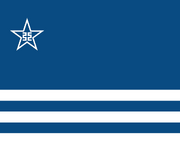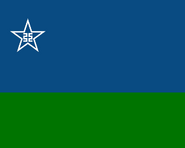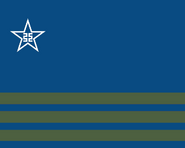| People's Liberation Army 人民解放軍 Rénmín jiěfàngjūn | |
|---|---|
| File:Flag of the People's Liberation Army.png 200px War Flag of the Imperial Armed Forces Emblem of the Imperial Armed Forces | |
| Founded | 3341 |
| Current form | 5007 |
| Service branches |
|
| Headquarters | Tian'an, Han |
| Leadership | |
| Chairman of the Central Military Commission | Chairman Mao Zheng |
| Minister of Defense | Xu Zhaohui |
| Vice-Chairman, IMC | General Jin Xinyi |
| Manpower | |
| Military age | Mandatory from 18, mandatory 20 to 38 years of age for male. |
| Conscription | 20–24 months depending on the branch |
| Deployed personnel | Unknown |
| Expenditures | |
| Budget | ¥700,000,000,000 INS $33b LOD |
| Percent of GDP | 6% |
| Industry | |
| Domestic suppliers | |
| Related articles | |
| History | History of Indrala |
| Ranks | Military ranks of the Imperial Indralan Armed Forces |
The People's Liberation Army (Indralan: 帝国武装部队; tr. Rénmín jiěfàngjūn) are the unified armed forces of the State of Indrala. Indrala's current armed forces were first established in 3341 and celebrated on Armed Forces Day. At the current time, after the Sun Reforms underneath Minister of Defense Sun Hui in the summer of 4620, the Imperial Armed Forces comprise five primary branches, the Imperial Army Found Forces, the Imperial Army Navy, the Imperial Army Air Force, the Imperial Army Rocket Force and the Imperial Army Strategic Support Force. Each of these branches has an appointed "Commander" who is appointed by the Imperial Military Commission.
At one time the Imperial Army of Indrala had one of the largest standing armies in the world and the Indralan Navy was one of the worlds few blue-water navies. According to the Zardic Institute of International Relations Indrala and it's armed forces are ranked as a "Great Power" capable of projecting power and influence across the world.
History[]
Cildanian Civil War[]
The Imperial Army Ground Forces and Imperial Army Navy intervened late in the Cildanian Civil War. The Jien Faction, the largest and most prominent ruling faction in Indrala brought to the National Assembly and the Council of Military Affairs a request from Indrala's ally, Dorvik. Dorvik had requested that the Indralan's intervene in the conflict, shortly before doing so the Imperial government of Cildania collapsed. The collapse of the Imperial government saw the rise of a provisional government underneath the Apostolic Army in Majatra and eventually the rise of a military government. Senior General Zhou Jing, the Chief of Staff of the General Staff Department and Commander of the Imperial Army Ground Force announced that the Imperial Army would be providing support alongside Dorvik, Trigunia and several other nations.
The bulk of the force was from the Imperial Army Navy commanded by Admiral Bo Xun alongside Senior General Zhou Jing. It was the first test for the Imperial Army, many defense experts throughout the world considered the Indralan military a "paper dragon" that it looked fierce but lacked the capabilities of its counter-parts such as Dorvik or Trigunia. General Jing however set out on a two-fold mission, prove the capabilities of the Indralan military and to ensure that the Ahmadist in Cildanian did not gain a foothold. The Indralan part of the campaign began in late June 3876 with the Imperial Army Navy and Imperial Army Navy Marine Corps landing in Qart Yam and establishing a beachhead. After pushing south east towards Qildarmiim and Sis to grow a much larger supply chain with the ultimate goal to capture Namal Ḣaṡri. Following the campaign to push several rebel militias out of Qart Yam, the Imperial Army Armed Police offered their services to the local government in exchange for a temporary air base in Qart Yam. Junior General Wei Tang and Senior Colonel Xiang Du of the General Political Department were appointed to restore rule of law in areas conquered by the Imperial Army forces.
The Indralan Imperial Army launched a massive assault on Hadiik-Mijidiil encompassing more than one hundred thousand troops and all branches of the Imperial Army. The assault was directed by Senior General Zhou Jing in Qart Yam and ended several months later with he successful capture of Hadiik-Mijidiil and the near destruction of the Ahmadi State in Cildania. Senior General Zhou worked closely with the Cildanian government and secured approval for the construction of a naval base in Qart Yam, as well as a joint training center in Qart Yam as well. The successful close for Indrala in the Cildanian Civil War saw the Indralan military and state rise to a power never before seeing before.
Sun Reforms[]
The foundation of the Nationalist Revival Committee and the leadership of Shao Jianhong as the presumptive Chief Minister garnered the attention of many within the military and security forces. One such individual was former Senior Colonel Sun Hui, a member of the General Staff Department of the General Headquarters. Colonel Sun called for a "...principled overhaul of the General Headquarters" and was rebuked by many within the Ministry of Defense underneath previous leadership. In early September, 4619 when he met Chairman of the NRC Shao Jianhong, he proposed his ideas to him, Shao being a former IAGF Colonel. Shoa believed that the ideas were in-line with his own and appointed Sun Hui as the Secretary for National Defense within the NRC. When the NRC assumed power in March, 4620 Sun was temporarily appointed as the Minister of Defense and confirmed in May, 4620 by the Grand Assembly. In what the media coined the "Sun Reforms" the organization and formation of the Imperial Armed Forces was radically changed. He introduced a rebrand of the armed forces, announced the expansion of the the 14th Imperial Artillery Division to the Imperial Army Rocket Force, disbanded the Imperial Guard into the various special operation forces through the branches of service, introduced a radical overhaul of the General Headquarters that saw it replaced with the Imperial Military Commission and its expansion to 15 different offices, departments and staffs.
Mao Reforms[]
Soon after the Communist Party of Yingdala took power, Chairman Mao Zheng made some changes to the military. What he coined the "Mao Reforms", he introduces a rebrand of the armed forces and the Military Commission, he also transformed the role of the Chairman of the Military Commission to be commander in chief of the armed forces. He also saw to it that the People's Liberation Army would be the armed wing of the Communist Party of Yingdala and the formation of The National Security Bureau of the People's Liberation Army.
Organization and structure[]
Imperial Military Commission[]
The formation of the Imperial Military Commission which will be lead by the Chairman of the Imperial Military Commission, which is deiced by the Legislature of Yingdala, but is is customary that the Chairman of The National People's Committee will be the Chairman of the CMC .The CMC will have two Vice Chairmen, one will be the the Minister of Defense and the other will be the Chief of the Joint Staff Department. It will be assisted by an additional four members and can include up to six total members. The Imperial Military Commission will include the following departments and will function as the "general staff" of the Imperial Armed Forces. All branches of the CMC are lead by an appointed "Director" with the exception of the Joint Staff Department who bears the title of "Chief".
- General Office
- Joint Staff Department
- Political Work Department
- Logistical Support Department
- Equipment Development Department
- Training and Administration Department
- National Defense Mobilization Department
- Discipline Inspection Commission
- Political and Legal Affairs Commission
- Science and Technology Commission
- Office for Strategic Planning
- Office for Reform and Organizational Structure
- Office for International Military Cooperation
- Audit Office
- Agency for Offices Administration
Theater Commands[]
Underneath the leadership of Minister of Defense Li Heng Chin, the Imperial Armed Forces reorganized the Military Regions and created them as "Theater Commands". These Theater Commands are responsible for areas of operation across the globe. Each Theater Command has an appointed Commander who is appointed by the IMC. The Theater Command is responsible for all units underneath it. The five Theater Commands are the:
- Eastern Theater Command (based out of Min)
- Northern Theater Command (based out of Jiaozhi)
- Western Theater Command (based out of Anle)
- Southern Theater Command (based out of Shu)
- Central Theater Command (based out of Han).
The Northern Theater Command is responsible for Keris and Makon, namely focused on Trigunia. The Eastern Theater Command is responsible for Dovani, Temania and Vascania, largely focused on Kazulia, Lourenne and Hulstria and Gao-Soto. The Western Theater Command is focused on Seleya and Artania. The Southern Theater Command is focused on Majatra, largely focused on Vanuku, Zardugal and Istalia. The Central Theater Command is focused on operational planning and territorial defense of mainland Indrala.
Current leadership and notable personnel[]
This is the current leadership and notable personnel of the IAF which began their leadership tenure on February 5th, 4890.
Central Military Commission[]
- Chairman of the Central Military Commission - Chairman of the National People's Committee Mao Zheng
Vice-Chairmen of the CMC
- Admiral Zhou Bai (Commander of the People's Liberation Army Navy)
- Li Heng Chin (Minister of Defense)
- General Liu Wang (Commander of the People's Liberation Army Ground Force)
Member(s) of the CMC
- General Lin Qiang (Commander, People's Liberation Army Ground Force)
- General Qian Shuren (Commander, Imperial Army Rocket Force)
- General Xu Xuegang (Commander Imperial Army Air Force)
- General (Ground Forces) Xiong Xieren (Commander Imperial Army Strategic Support Force)
- General (IAGF) Yan Bo (Chief, Joint Staff Department)
- Admiral Xun Zemin (Director, Office for Strategic Planning)
Operational leadership[]
- Imperial Army Ground Forces - Commander: General Lin Qiang
- Imperial Army Special Operation Forces - Deputy Commander: Lieutenant General Xian Guiying
- Imperial Army Navy - Commander: Admiral Zhou Bai
- Imperial Army Navy Coastal Defense Forces - Deputy Commander: Rear Admiral Zheng Chin
- Imperial Army Navy Marine Corps - Deputy Commander: Rear Admiral Ye Chang
- Imperial Army Navy Special Operation Forces - Deputy Commander: Vice Admiral Feng Xuefeng
- Imperial Army Naval Air Force - Deputy Commander: Vice Admiral Han Jian
- Imperial Army Air Force - Commander: General Xu Xuegang
- Imperial Army Air Force Airborne Corps - Deputy Commander: Lieutenant General Yan Ju
- Imperial Army Air Force Special Operation Forces - Deputy Commander: Major General Zhao Zhen Kang
- Imperial Army Rocket Force - Commander: General Qian Shuren
- Imperial Army Strategic Support Force - Commander: General (Ground Forces) Xiong Xieren
- Imperial Army Strategic Space Corps - Deputy Commander: Lieutenant General (Air Force) Cao Jingyi
- Imperial Army Strategic Cyber Corps - Deputy Commander: Rear Admiral Gong Zhihao
- Imperial Army Strategic Logistics Support Corp - Deputy Commander: General (Ground Forces) Cheng Zhenya
- Imperial Army Strategic Special Operation Forces - Deputy Commander: Major General (Air Force) Zhen Xue
- Theater Commanders
- Eastern Theater Command - Admiral Ren Ling
- Northern Theater Command - General (Ground Forces) Ye Yun
- Western Theater Command - Admiral Lin Hong
- Southern Theater Command - General (Air Force) Pan Yimu
- Central Theater Command - General (Ground Forces) Qiao Yuhan
Branches of the Imperial Army[]
Imperial Army[]

Soldiers of the Imperial Army Ground Forces.
The People's Liberation Army Ground Force (Indralan: 人民解放軍, Rénmín jiěfàngjūn) is the largest branch of the Imperial Army. The Imperial Army Ground Forces is commanded by the Commander of the Imperial Army Ground Force, who serves as the Chief of Staff of the General Staff Department and the Grand Guardian. The Imperial Army Ground Force has the largest bulk of military equipment within the Imperial Army, it is currently the largest standing army in the world with somewhere near a 3 million active men and women with nearly 5 million more able to be mobilized.
The Imperial Army Ground Force maintains its own air forces, primarily helicopters and strategic airlifting planes. The Imperial Army Ground Force Air Force is smaller than the Imperial Army Air Force and the Imperial Army Navy Air Force but maintains an important combined arms role in close air support and strategic airlifting.

Naval ensign of the IAN
The People's Liberation Army Navy (Indralan: 解放軍海軍; tr. Jiěfàngjūn hǎijūn) is the naval arm of the People's Liberation Army and the second largest branch. The PLAN, as it is commonly known, is comprised of 6 sub-branches. The People's Liberation Army Navy Surface Force, the Peoples Liberation Army Navy Submarine Force, the People's Liberation Army Coastal Defense Forces, the People's Liberation Army Navy Marine Corps, the People's Liberation Army Navy Air Force and the People's Liberation Army Navy Special Forces. Each is responsible for their own sphere of influence and commanded by commanders of the Imperial Army Navy. The Commander of the Imperial Army Navy serves as a sort of second in command of the Imperial Army due to the rising role of the Imperial Army Navy throughout the world. The Imperial Army Navy has several hundred ships and commands a sizable submarine fleet. The Imperial Army Navy Air Force is the second largest air force contingent in Indrala and serves primarily aboard ships with small helicopter hangers and the Tian'an-class aircraft carrier, an Indralan license production of the Petrovgrad-class nuclear aircraft carrier.
Imperial Air Force[]

Flag of the Imperial Army Air Force
The Imperial Army Air Force (Indralan: 帝國軍空軍; tr. Dìguó jūn kōngjūn) is the primary aerial warfare arm of the Imperial Armed Forces. The IAAF, as it is commonly called, is responsible for most aircraft operations throughout Yingdala. While the Imperial Army Ground Forces and the Imperial Army Navy maintain their own branches of aircraft, the bulk of the IAF's aerial resources are contained within the IAAF. The IAAF also is in command and control over the Imperial Army Air Force Airborne Corps (Indralan: 帝國軍空軍空降軍; tr. Dìguó jūn kōngjūn kōngjiàng jūn), the paratroopers of the Imperial Armed Forces.
Similar to each branch of the Imperial Armed Forces, the Imperial Army Air Force possesses its own special forces known as the Imperial Army Air Force Special Operations Forces.
Imperial Army Armed Police[]

Flag of the IAAP
The Imperial Army Armed Police is a gendarmerie force of the Imperial Army, it backs up the civilian police when requested and acts as a military police for the military. The Imperial Army Armed Police work underneath a hybrid command of several offices and departments of the Imperial Military Commission, namely the Political Work Department, Discipline Inspection Commission and the Political and Legal Affairs Commission. The IAAP are also responsible for the security of military installations across Yingdala. The Imperial Army Armed Police are what staff military security battalions and act as a rear guard. They are both a feared and loved aspect of the Imperial Army, they are traditionally the most incorruptible officials.
Imperial Army Rocket Force[]

Flag of the IARF
The Imperial Army Rocket Force (Indralan: 帝國陸軍火箭隊; tr. Dìguó lùjūn huǒjiàn duì) is the strategic missile force of the Imperial Armed Forces. It was previously known as the 14th Artillery Division. The IARF, as it is commonly known, control both strategic and tactical conventional and nuclear weapons. Limited intelligence reports have placed the Indralan government capable of producing nuclear weapons and reports are that there is a limited number of nuclear weapons possessed by Yingdala. Officially, the policy towards nuclear weapons of the Imperial Armed Forces and Yingdala as a whole is a nuclear deterrent and an "...option of last resort."
The National Security Bureau of the People's Liberation Army[]
Main article: The People's Liberation Army State Security
The National Security Bureau of the People's Liberation Army (Indralan: 中國人民解放軍國家安全局; tr. Zhōngguó rénmín jiěfàngjūn guójiā ānquán jú) is the civilian intelligence, security and secret police agency of the People's Liberation Army, although a army branch it is not restricted from taking part in national surveillance of the population and has power of arrest in the national population and in the military. The objective of the NSBPLA is to ensure the security of Yingdala by surveillance of all the military branches and of the national population and through effective measures against spies, and counter-revolutionary activities and to look out for anyone who objects the regime. It is planned that there will be 3,000 agents in each branch and 5,000 agents for each 50,000 people.
Former branches[]
Imperial Guards[]
The Imperial Guards were the collective name for the Imperial Army Special Forces (which the Imperial Guards are also known as) that was underneath the direct command of the August-Sage King and the Council of Military Affairs. The numbers of Imperial Army Special Forces was a highly regarded state secret though outside experts speculate that there is some 10,000 Imperial Army Special Forces troops. The Imperial Guard and their more modern name of the "Imperial Army Special Forces" was disbanded underneath the Sun Reforms and broken into a series of branch-specific special forces.









